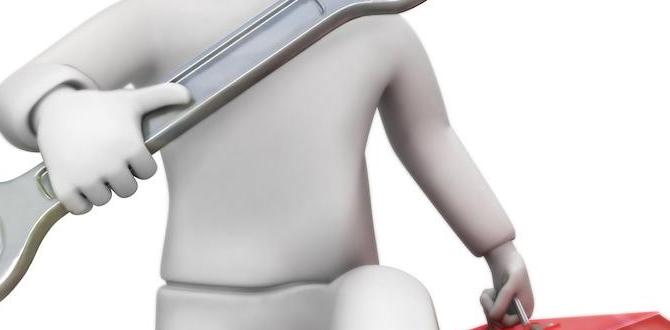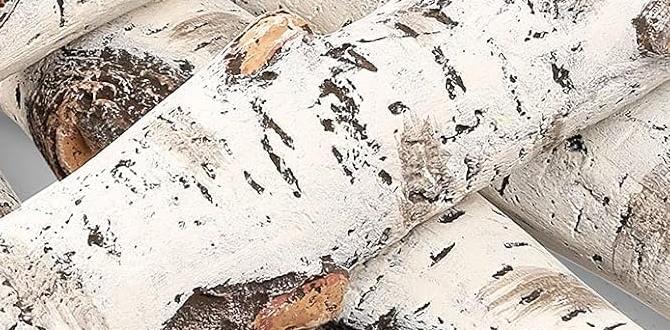Nail gun depth adjustment is crucial for sinking nails perfectly without damaging your material. Correctly adjusting your nail gun’s depth ensures a clean, professional finish every time, preventing over-driven or under-driven nails, which can ruin your project and waste materials. Mastering this simple setting will significantly improve your woodworking results.
Hey there, fellow woodworkers and DIY enthusiasts! Jack Shaffer here, your go-to guide for all things nailers and tools. Ever fired up your nail gun, ready to join two pieces of wood, only to have the nail head either pop out or plunge too deep, leaving a messy divot? It’s a common frustration, especially when you’re aiming for that smooth, professional finish. But don’t worry, getting that perfect nail depth is well within your reach. It’s all about understanding and using your nail gun’s depth adjustment feature correctly. This simple setting can be the difference between a project you’re proud of and one that needs extra work to fix. Today, we’re going to walk through everything you need to know to master nail gun depth adjustment, ensuring every nail you drive is exactly where it needs to be. We’ll cover why it’s so important, how the adjustment mechanism works, and some tried-and-true tips to get it dialed in for any project. Let’s get those nails sinking just right!
<h2>Why Nail Gun Depth Adjustment Matters</h2>
Getting the depth just right on your nail gun isn’t just about aesthetics; it’s about functionality and the integrity of your work. When a nail is driven at the correct depth, it provides a strong, secure connection between your materials. Too shallow, and the nail can pull out under stress, weakening the joint. Too deep, and you risk damaging the wood. This is particularly important when working with softer woods or when the surface will be visible in the final project.
<h3>Achieving a Professional Finish</h3>
For projects where appearance is key, like furniture making or decorative trim, consistent and precise nail depth is non-negotiable. You want the nail head to be just flush with the surface, or perhaps slightly countersunk for filling and painting. An improperly set nail gun can leave heads standing proud, creating an unprofessional look, or drive nails too deep, creating unsightly holes that require significant filling and sanding.
<h3>Ensuring Structural Integrity</h3>
In more structural applications, like framing or deck building, the depth of the nail directly impacts the strength of the joint. Nails driven too shallow might not hold the pieces together reliably. Conversely, nails driven too deep can compress or even split the wood fibers around the nail, weakening the connection over time. The right depth ensures the nail can do its job effectively and durably.
<h3>Saving Time and Materials</h3>
Constantly having to fix over-driven or under-driven nails can be a major time sink. It means extra trips back to the tool, potentially more material waste if you have to discard a damaged piece of wood, and additional work for repairs. Mastering depth adjustment means smoother workflow, fewer errors, and ultimately, less frustration and more finished projects.
<h2>Understanding Your Nail Gun’s Depth Adjustment Mechanism</h2>
Most modern nail guns, whether they’re pneumatic, cordless, or electric, feature an adjustable depth setting. The way you access and control this setting can vary slightly between brands and models, but the principle remains the same: you’re controlling how far the nose of the nailer depresses before firing.
<h3>Common Adjustment Types</h3>
Let’s look at the most typical ways nail gun depth is adjusted:
<strong>Dial or Wheel Adjusters:</strong> Many nail guns have a small dial or wheel located near the nose of the gun, often on the side or top. Turning this dial typically adjusts the depth in small increments. Some might have a positive stop for flush settings, while others offer a continuous range.
<strong>Thumb Screws or Levers:</strong> Some models use a spring-loaded thumb screw or a lever mechanism. You might need to pull this component out and then twist it to adjust. Releasing it locks it into place at the desired depth setting.
<strong>Tool-Free Shoe Adjustments:</strong> Higher-end nail guns often feature tool-free depth adjustment systems. These are usually integrated into the nosepiece and allow for quick, tool-free changes, often with detents or clicks for consistent settings.
It’s always a good idea to consult your nail gun’s user manual to understand the specific adjustment mechanism for your model. You can usually find these manuals online on the manufacturer’s website if you no longer have the physical copy. For example, DeWalt’s extensive support pages offer manuals for many of their tools.
<h3>How it Works Internally</h3>
At its core, the depth adjustment mechanism modifies the distance the driver blade moves forward. When you adjust the depth, you’re essentially changing the position of a stop or a spring mechanism relative to the firing mechanism. This dictates how much the nose of the nailer must be pressed into the material before the internal firing pin can be released to drive the nail. A shallower setting means less travel for the driver blade, while a deeper setting allows for more travel.
<h2>Step-by-Step Guide: Adjusting Your Nail Gun for Precision</h2>
Mastering depth adjustment is a process of understanding your tool and practicing. Follow these steps to get it right every time.
<h3>Step 1: Safety First!</h3>
Before you touch any adjustment or even load nails, always prioritize safety.
<strong>Disconnect Power:</strong> For pneumatic nailers, disconnect the air hose. For cordless or electric models, remove the battery or unplug it from the power source.
<strong>Wear Safety Glasses:</strong> Always wear ANSI-approved safety glasses or goggles when operating any power tool, and especially when testing nail gun depth.
<h3>Step 2: Identify Your Adjustment Control</h3>
Locate the depth adjustment mechanism on your specific nail gun. Refer to your user manual if you’re unsure. It’s typically a dial, wheel, or lever near the front of the tool.
<h3>Step 3: Select a Scrap Piece of Material</h3>
Grab a piece of scrap wood that is the same type and thickness as the material you’ll be working with for your project. This is crucial because different wood densities and thicknesses will affect how the nail sinks.
<h3>Step 4: Set an Initial Depth</h3>
Start with a moderate setting. If your dial has numbers, a middle setting is usually a good starting point. If it’s a continuous dial, just pick a spot somewhere between deep and shallow. Ensure the nail gun is still disconnected from its power source.
<h3>Step 5: Prepare for the Test Drive</h3>
<strong>Connect Power:</strong> Reconnect the air hose or battery/plug.
<strong>Load Nails:</strong> Load the appropriate nails for your project into the nail gun.
<strong>Position the Nailer:</strong> Place the nose of the nail gun firmly against your scrap material. Make sure it’s flat and stable.
<h3>Step 6: Drive a Single Nail</h3>
Firmly press the nose of the nail gun against the wood and squeeze the trigger.
<h3>Step 7: Inspect the Result</h3>
Carefully examine how the nail has penetrated the wood.
<strong>Are you happy?</strong> If the nail head is perfectly flush or at your desired depth (e.g., slightly countersunk for filling), congratulations! You’ve found your setting.
<strong>Too shallow?</strong> If the nail head is sticking out or barely embedded, you need to set the nail gun to drive deeper. Turn the adjustment mechanism towards the “deeper” or “+” setting.
<strong>Too deep?</strong> If the nail has punched through the back of the scrap or created a significant divot, you need to set the nail gun to drive shallower. Turn the adjustment mechanism towards the “shallower” or “-” setting.
<h3>Step 8: Repeat and Refine</h3>
After making an adjustment, drive another nail into a different spot on your scrap material. Continue this process of adjusting, firing, and inspecting until you achieve the perfect depth. It might take a few attempts, but it’s much better to do it on scrap than on your actual project!
<h3>Step 9: Lock It In and Proceed</h3>
Once you’re satisfied with the depth on your scrap material, begin working on your project. Remember that different wood types and even different sections of the same wood can sometimes require minor adjustments on the fly, but this initial setting will get you very close.
<h2>Nail Gun Depth Adjustment Tips for Specific Materials</h2>
The material you’re working with plays a huge role in how deep a nail will penetrate. Adjusting your nail gun depth based on the material is key to consistent results.
<h3>Softwoods (Pine, Fir, Cedar)</h3>
Softwoods are, well, soft! This means nails will sink more easily.
Recommendation: You’ll generally need to set your nail gun to a shallower depth to prevent over-driving nails and avoid splintering or creating large divots.
Testing: Drive a nail, and if the head is significantly below the surface, you’ve gone too deep. If it’s proud of the surface, you need to go deeper. For finishing nails on pine, you often want the head just flush or slightly below the surface.
<h3>Hardwoods (Oak, Maple, Cherry)</h3>
Hardwoods are denser and offer more resistance, requiring more power and potentially a deeper setting.
Recommendation: You might need to set your nail gun to drive a bit deeper than you would for softwoods. This ensures the nail fully penetrates the material for a secure hold.
Testing: Be vigilant for under-driven nails. If the nail head isn’t flush, increase the depth. Hardwoods are more forgiving with slightly deeper settings than softwoods, as they are less prone to splintering around the nail head.
<h3>Plywood and Engineered Woods</h3>
These materials can be tricky because their internal structure varies.
Recommendation: Treat plywood like a medium-density wood. Start with a moderate setting and adjust. Be aware of the veneer layers on top; driving too deep too quickly can blow out the surface.
Testing: Pay close attention to the surface veneer. You want the nail head to be flush without damaging the top layer.
<h3>Veneers and Thin Materials</h3>
Working with delicate veneers or thin trim requires extreme caution.
Recommendation: These materials are highly susceptible to damage. You’ll likely need the shallowest possible setting and may even find specialized “detail” or “brad” nailers with lighter drivers are better suited. Some nail guns have a “contact trip” mode that requires the nose to be pressed against the surface before firing, which can help prevent accidental firing into thin air.
Testing: A single test is usually enough to see if you’re causing damage. If the veneer cracks or lifts, you need to adjust shallower immediately.
<h3>Metal or Plastic Surfaces</h3>
While less common for typical woodworking, some projects might involve these.
Recommendation: Standard nail guns are not designed for driving nails into metal or hard plastics without specialized fasteners or tools. For materials like thin sheet metal, you might need a framing nailer with a higher PSI and a deeper setting, but this is an advanced application. For most DIYers, it’s best to use adhesives or screws for these materials.
External Link: For professionals working with metal, specialized tools like Pin Nailers or Gas-Powered Nailers exist. Learn more about the types of nailers and their applications on resources like Tooling.com.
<h2>Advanced Nail Gun Depth Adjustment Tips</h2>
Once you’ve got the basics down, here are some expert tips to refine your technique and tackle more challenging situations.
<h3>Understanding Air Pressure (for Pneumatic Nailers)</h3>
For air-powered nail guns, the depth setting works in conjunction with air pressure. Higher air pressure will drive nails with more force, potentially leading to deeper penetration even at the same depth setting.
Recommendation: Ideal operating pressure for most nailers is typically between 70-120 PSI. Always check your tool’s manual. It’s best to set your pressure within the recommended range first, and then fine-tune the depth adjustment.
Troubleshooting: If you’re at the maximum depth setting and nails are still too shallow, increasing the PSI (within the tool’s limits) might be necessary. Conversely, if nails are consistently too deep even at the shallowest setting, reducing PSI can help, though the primary adjustment should be the depth dial. Resources like the Occupational Safety and Health Administration (OSHA) provide guidelines for safe use of compressed air.
<h3>The “Flipping It Over” Test</h3>
A quick and effective test for depth, especially for trim or moldings, is to drive a nail into the scrap wood, then gently turn the scrap piece over. If the nail point is visible and protruding slightly, you’re likely at a good flush or slightly countersunk depth. If it’s significantly protruding, you’re too deep. If it’s not visible at all, you’re too shallow.
<h3>Countersinking vs. Flush Setting</h3>
<strong>Flush Setting:</strong> The nail head sits perfectly even with the surface of the wood. This is common for many projects where you plan to paint or where the nail will be visible.
<strong>Countersinking:</strong> The nail head is driven slightly below the surface of the wood. This is ideal when you plan to fill the nail holes with wood filler or putty for a completely smooth, invisible finish. You can often achieve a slight countersink by simply increasing the depth setting slightly from your “flush” setting.
<h3>Consider the Nail Type</h3>
Different nails (brad, finish, brad head, headless) have varying shank diameters and head sizes. This can subtly influence how they behave. Thicker shank nails require more force and might behave differently than very thin brad nails. Ensure you are using the correct nail type for your nail gun and project.
<h3>Using the Safety Tip (Contact Trip)</h3>
Most nail guns have a safety tip or contact nose. This feature prevents the gun from firing unless it’s pressed firmly against a surface. Always ensure this safety tip is depressed; this is part of the mechanism that allows the nail to be driven. Some jobs, like working with very thin materials with an angled nailer, might require you to press the safety tip against your workpiece while also pressing the tool against your material and pulling the trigger.
<h3>When to Use a Different Nailer</h3>
Sometimes, no matter how you adjust your current nail gun, you can’t achieve the perfect depth or avoid damaging the material. This might be a sign you need a different type of nailer.
Detail Work/Molding: For delicate trim and molding, a brad nailer or finish nailer is often sufficient and easier to control.
Small Projects/Crafts: Pin nailers (which drive headless pins) are excellent for very fine work where you want almost no visible mark.
Framing: For heavy-duty framing, you need a framing nailer that can drive longer, thicker nails with significant force.
<h2>Troubleshooting Common Depth Issues</h2>
Even with careful adjustment, you might encounter problems. Here’s how to fix them.
<h3>Nails are Always Too Shallow</h3>
Check Air Pressure (Pneumatic): Ensure your compressor is set to an adequate PSI and that there are no major leaks in your hose or connections.
Maximize Depth Setting: Adjust the depth dial to its deepest setting.
Consider Tool Limitations: Your nailer might not have enough driving power for the lumber you’re using. You may need a nailer with higher PSI capabilities or a different type of nailer.
Check for Blockages: Occasionally, debris can partially obstruct the driver mechanism.
<h3>Nails are Always Too Deep (Damaging Wood)</h3>
* Minimize Depth Setting: Adjust the depth dial to its shallowest



